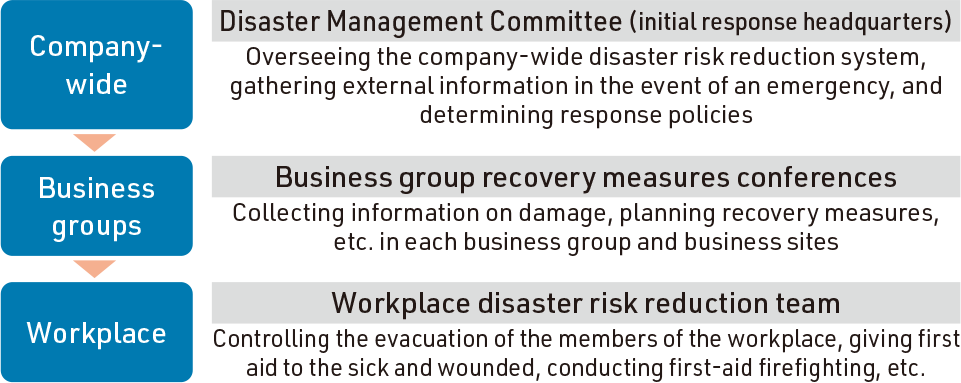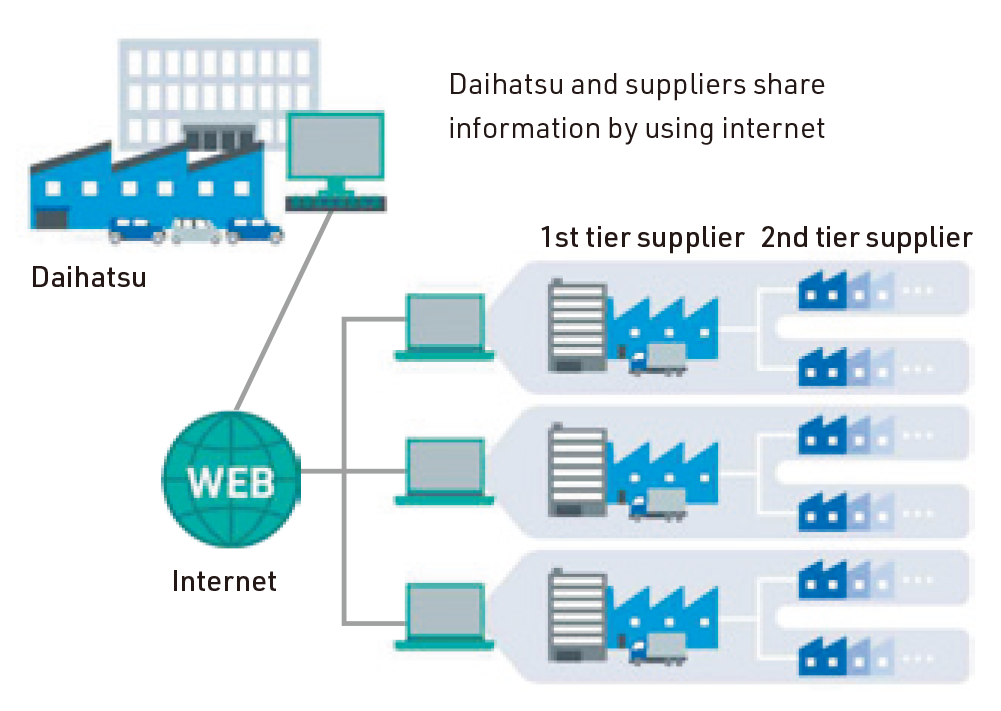Risk Management
Fundamental Approach
Daihatsu’s PDCA cycle involves prioritizing risks to the entire organization based on their importance to corporate management (likelihood of occurrence, degree of impact, status of measures) and taking measures against them. We aim to establish and keep improving activities that continuously implement this cycle.
Risk Management Process
Regular Risk Management Process
Daihatsu identifies risks in each division, analyzes them across the company, and prioritizes them. We then identify risks that should be managed as a priority and consider and promote measures against them. In addition, the GRC Committee periodically follows up on and monitors the progress of the identified risks.
Emergency Risk Management System
In the event of a major management crisis or emergency situation such as a disaster, Daihatsu establishes an emergency response task force to take appropriate measures to deal with the situation.
Business Continuity Management
Daihatsu has formulated business continuity plans (BCPs) to minimize the impact of risks in corporate management and ensure early recovery and business continuity. In doing so, we are working to avoid and reduce risks.
In particular, as part of our initial response in the event of a disaster, we have established a company-wide Disaster Management Committee that involves all divisions within the company. We also register information on the safety of employees from the website, telephone, mobile app, and other sources into the system. In doing so, we have created a safety confirmation system that allows the company and workplace supervisors to quickly confirm the safety of employees. We have also created a disaster prevention manual that outlines the standards for employee behavior in the event of a major disaster, as well as initial response and recovery procedures. By clarifying the process from the occurrence of a disaster to recovery and working to instill these procedures through training, we are working to build a corporate structure that is resilient to disasters.
Disaster Management System
To properly manage crises during emergencies such as disasters, Daihatsu established an initial response system with roles specified on three levels: the company-wide level, the business group level, and the workplace level. In addition, we are working to improve the accuracy and effectiveness of initial responses by conducting company-wide initial response training and safety confirmation training using the safety confirmation system in collaboration with Group companies.
Promotion structure
Initiatives to Mitigate the Impact of Disasters on Buildings and Equipment
Daihatsu works to mitigate the impact of disasters on buildings and equipment in order to reduce any human injury and property damage in the event of a disaster and resume production immediately after shifting to the business restoration phase. Our new buildings sufficiently meet the latest earthquake-resistance standards. Furthermore, each of our buildings built according to former earthquake-resistance standards has received earthquake-resistance testing and been retrofitted as needed. With respect to production equipment, we identify hazards, such as collapse, fire, and power loss in the event of a disaster, as well as risks that may affect manufacturing quality and incorporate reasonable countermeasures into equipment specifications and operational methods.
Building a Disaster-resilient Supply Chain
To implement recovery support at an early stage and accelerate support in the event of a disaster, Daihatsu is working with its suppliers to develop a supply chain that is highly resilient against disasters. By establishing the SCRK* system during normal times, we are making supply chain information visible and preparing for a disaster. Specifically, we created a database based on information provided by suppliers and use this database to identify damage in a disaster and confirm whether support is needed.
* SCRK: Supply Chain Resiliency Keeper
Image of SCRK system operation
Information Management
Information Security
Based on the recognition that information security is an important foundation for business continuity, we thoroughly disseminate the management rules for confidential information, products, and facilities. In order to ensure the rules, we provide information security education to employees, including training at the time they join the company. In addition, we have established an information security enhancement month to share the latest information in order to raise employee awareness of information security and prevent leaks of confidential information.
Protection of Personal Information
We have established a privacy policy and its management method in order to protect important personal information received from stakeholders. The privacy policy is regularly updated in response to amendments to the Act on the Protection of Personal Information. As part of our personal information protection activities, we conduct audits, select appropriate third parties, and sign memorandums of understanding on personal information protection.
Initiatives to Respect for Privacy
In order to proceed and respond to privacy protection that is close to our customers, Daihatsu has built a company-wide governance system and shares issues in the Information Security Committee. We are working to ensure safety and protect privacy in a way unique to Daihatsu by utilizing diverse information.



